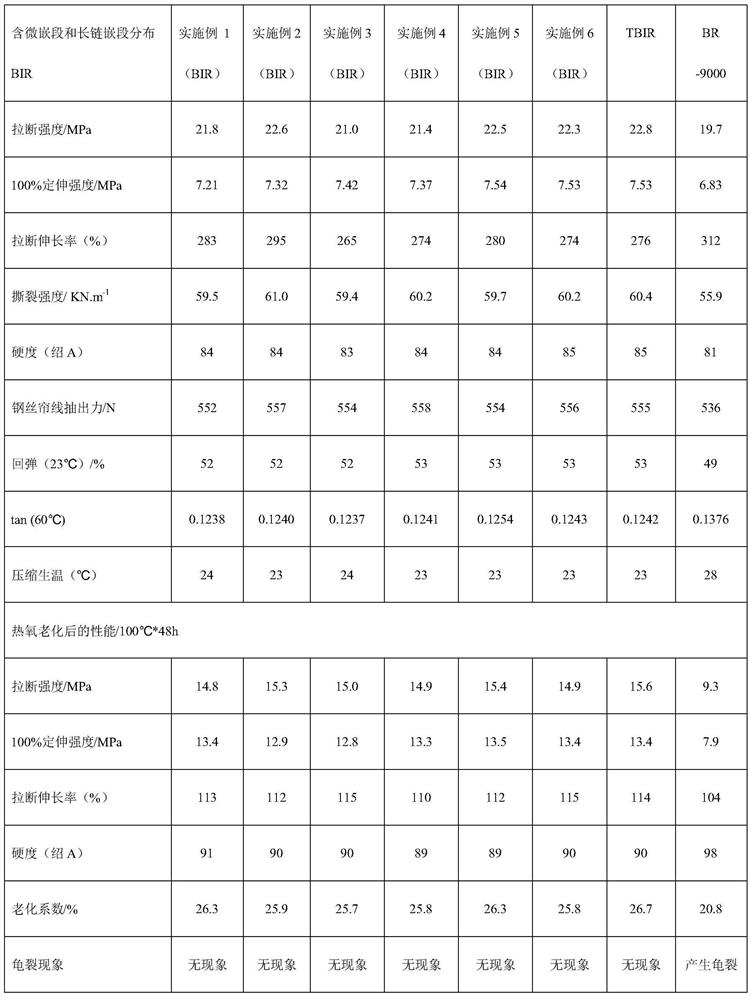Anti-cracking and anti-aging radial tire tread base rubber and preparation method of rubber
A radial tire and tread base technology, applied in the field of tire rubber, can solve the problems of poor processing performance, carcass cracking, rubber tearing and falling off, etc., to improve strength and melt elasticity, reduce tire rolling resistance, and improve tire rolling resistance. The effect of carcass stress
- Summary
- Abstract
- Description
- Claims
- Application Information
AI Technical Summary
Problems solved by technology
Method used
Image
Examples
Embodiment 1
[0072] Add 7000mL of n-hexane to a 10-liter polymerization kettle under the protection of nitrogen, start stirring, then add 0.05mL of anisole with a mass fraction of 99.0%, and then raise the temperature of the polymerization solution to 70°C; Press the pre-selected mixed monomer composed of butadiene, isoprene and divinylbenzene into the polymerization kettle (the mixed monomer consists of 1055g butadiene, 305g isoprene and 1.5mL divinylbenzene Benzene), while continuously adding 0.70mol / L of NBL12mL from the sight glass of the polymerization kettle, the polymerization time of monomer and NBL being continuously added to the polymerization kettle at the same time is 60min, and the polymerization reaction is carried out under adiabatic conditions. When the monomer and NBL After the addition, the polymerization temperature reaches 85-90°C. At this time, add 50mL of isoprene for the second molecular chain extension at one time, and react for 20 minutes at the temperature of the p...
Embodiment 2
[0076] Keep the relevant process conditions in Example 1 unchanged, only 0.08mL of anisole is added, and the mixed monomer used in the first stage is composed of 1055g of butadiene, 305g of isoprene and 1.8mL of divinylbenzene , The added butyllithium is 16mL, the continuous feeding time of mixed monomer and NBL is 70min, the amount of isoprene added in the second stage is 80mL, and the N,N'-dimethylimidazolinone used for capping the active chain lithium 15mL.
[0077] The results are measured: the number average molecular weight Mn=12.6×10 of raw rubber 4 , molecular weight distribution index D=1.83; the 1,2-addition unit content in the polybutadiene unit in the raw rubber is 7.87%, and the trans 1,4-addition unit content is 81.34%; the polyisoprene unit The content of 3,4-addition units is 5.64%, and the content of trans 1,4-addition units is 87.21%. The Mooney viscosity ML of raw rubber is 50.6; Tg is -78.8°C.
Embodiment 3
[0079] The relevant process conditions in Example 1 remain unchanged, only 0.10 mL of anisole is added, and the mixed monomer used in the first stage is composed of 800 g of butadiene, 533 g of isoprene and 2.2 mL of divinylbenzene , the added butyllithium is 14mL, the continuous feeding time of mixed monomer and NBL is 80min, the amount of isoprene added in the second stage is 100mL, and the amount of 0.71mol / L tributyltin chloride used for capping the active chain lithium is 14 mL of hexane solution.
[0080] The result is measured: the number average molecular weight Mn=14.2×10 of raw rubber 4 , molecular weight distribution index D=1.88; the content of 1,2-addition units in polybutadiene units in raw rubber is 8.54%, and the content of trans 1,4-addition units is 82.65%; the content of polyisoprene units in The content of 3,4-addition units is 7.48%, and the content of trans 1,4-addition units is 85.94%. The Mooney viscosity ML of raw rubber is 56.8; Tg is -81.4°C.
PUM
| Property | Measurement | Unit |
|---|---|---|
| Glass transition temperature | aaaaa | aaaaa |
| Tg | aaaaa | aaaaa |
| Tg | aaaaa | aaaaa |
Abstract
Description
Claims
Application Information
 Login to View More
Login to View More - R&D
- Intellectual Property
- Life Sciences
- Materials
- Tech Scout
- Unparalleled Data Quality
- Higher Quality Content
- 60% Fewer Hallucinations
Browse by: Latest US Patents, China's latest patents, Technical Efficacy Thesaurus, Application Domain, Technology Topic, Popular Technical Reports.
© 2025 PatSnap. All rights reserved.Legal|Privacy policy|Modern Slavery Act Transparency Statement|Sitemap|About US| Contact US: help@patsnap.com

